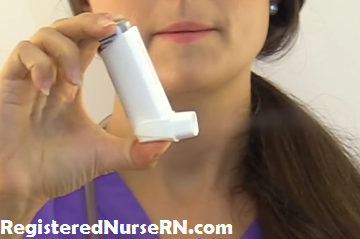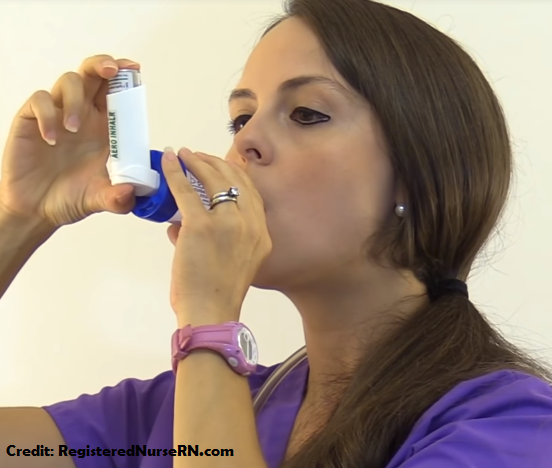This article will demonstrate how to use a spacer with a metered-dose inhaler (MDI).
What is a metered-dose inhaler (MDI)? It’s an inhaler used to administer a set amount of medication into the lungs. Medications that are used include bronchodilators, corticosteroids etc.
What is a spacer used with a metered-dose inhaler? A spacer is an extra attachment that is connected to an inhaler. It creates a chamber-like space that holds the medication and gives the patient time to inhale the medication (instead of having to press down the inhaler while simultaneously inhaling the medication…this takes a lot of practice).
Therefore, it helps decrease the amount of medication that will collect in the mouth rather than the lungs, and it makes using a MDI easier when compared to using the open or closed-mouth techniques (which is very important for younger or older patients who have trouble with using a MDI).
Video on using a Spacer with Metered-Dose Inhaler
Important Facts about MDIs:
Types of MDIs:
- Bronchodilators: Albuterol (also called Ventolin HFA or ProAir HFA)
- Corticosteroids: Fluticasone (also called Flovent HFA)
- Also, a single inhaler can be used which contains a combination of drugs like Symbicort (this contains both a bronchodilator and corticosteroid).
Metered-Dose Inhaler Spacer Demonstration
- Perform hand hygiene
- Perform the patient’s 5 rights (right patient, right time, right route, right drug, right dose)
- How many puffs are being administered? If 2 or more…give one puff and wait 1 minute before the next one.
- Look at the inhalers ordered: are you giving both a bronchodilator and corticosteroid inhaler?
- Which one will you administer first? The BRONCHODILATOR and then the corticosteroid.
- WHY? The bronchodilator will open the airways to allow the corticosteroid to work. *Wait 5 minutes in between the bronchodilator and corticosteroid
- Confirm there are enough doses in the inhaler:
- To do this, look at the inhaler’s counter (found on the inhaler) or look at how many sprays are in each inhaler (found on the box).
- Which one will you administer first? The BRONCHODILATOR and then the corticosteroid.
3. Prime the inhaler:
- When do you prime the inhaler?
- First time using, haven’t used in 1 or more weeks, dropped it, or recently cleaned it
- Note: Every inhaler is different in how many spray are needed to prime the inhaler, so always read the instructions.
- First time using, haven’t used in 1 or more weeks, dropped it, or recently cleaned it
1.Remove the cap.
2. Shake it up and down for 8 to 10 seconds.
3. Spray it in the air per the inhaler’s manual instructions. Be sure to keep it away from yourself and other people.
 4. Have the patient sit-up.
4. Have the patient sit-up.
5. Hold the inhaler in between the thumb and two fingers (make sure the inhaler’s cap is removed).
6. Connect the inhaler to the spacer and remove the cap from the mouthpiece of the spacer.
 7. Shake the inhaler for 8-10 seconds.
7. Shake the inhaler for 8-10 seconds.
8. Breathe in and breathe out all the way through the mouth (not nose) until can no longer.
9. Seal lips around the mouth piece of the spacer by placing the mouth piece in between the teeth with the tongue flat.

10. Press down the inhaler and THEN breathe IN slowly through the mouth…keep breathing in until no longer able.
11. Hold breath for 10-12 seconds and then breathe out slowly.
***Gargle Rinse mouth with water and SPIT after using a corticosteroid
*If more than 1 puff ordered, repeat in one minute.
12. Then recap inhaler and spacer.
More Nursing Skills